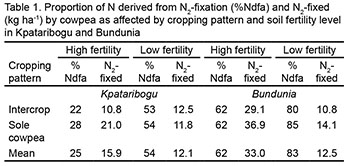I conducted intercropping trials as key part of my PhD study, for the 2013 and 2014 seasons in the southern (Kpataribogu) and northern (Bundunia) Guinea savanna in northern Ghana. Cowpea, soyabean and groundnut were each intercropped with maize in different planting arrangements. The research objectives were to examine the effects of soil fertility level and different spatial intercropping arrangements (cropping patterns) on maize and legume grain yields, intercrop efficiency and productivity; and to assess the effects of soil fertility level and cropping patterns on N2-fixation in the two sites. In this update, I present the results of the grain yields of the maize-cowpea system and N2-fixation by cowpea in 2013.
|
The full paper is currently under preparation. Cowpea and maize grain yields significantly differed (P<0.001) among cropping patterns, soil fertility level and sites (Figure 1). Grain yields of sole cowpea and maize were significantly larger, as compared to the intercrop grain yields. |
Figure 1. Cowpea and maize grain yields as affected by spatial plant arrangement and soil fertility level in 2013 in Kpataribogu and Bundunia. The error bars show the standard error of difference between means (SED) |
Land size for each intercrop was half the size of land used for each sole crop. Therefore, comparing 50% of each sole crop yield to the respective intercrop yield means comparing equivalent size of land for intercrops and sole crops. The results showed that cowpea and maize intercrop grain yields were significantly higher, as compared with 50% of the sole cowpea and maize yields, respectively. Hence, the results indicated that more land will be required by each sole crop to produce the same grain yield as the intercrops.
The within-row intercrops provided significantly greater grain yield than the 1 to 1 and 2 to 2 distinct row intercrops, both of which did not differ significantly. Cowpea grain yield was significantly larger in Bundunia, while maize grain yield was significantly greater in Kpataribogu. Maize and cowpea grain yields declined with soil fertility level. The high fertility fields significantly (P<0.001) provided larger grain yields than the low fertility fields. The proportion of N derived from N2-fixation (%Ndfa) generally did not differ between intercrop and sole crop (Table 1).
 |
However, the sole cowpea yielded significantly higher amount of N2 fixed than the intercrops, due to larger amount of above ground biomass produced. The low fertility field mostly provided a significantly larger %Ndfa than the high fertility field, but only at Bundunia. However, the amount of N2 fixed was significantly larger (P<0.001) in the high fertility field than the low fertility field due to larger amount of above ground biomass produced. The %Ndfa and amount of N2 fixed were significantly (P<0.001) larger at Bundunia, as compared to Kpataribogu. |
The results showed that intercropping improved the efficiency and productivity of the prevailing land to provide food. The within-row intercrop pattern seemed to be the more efficient and productive system. The distinct row intercrop patterns were also beneficial, as compared to sole crops. Low soil fertility enhanced the proportion of N derived from N2-fixation. However, good soil fertility is required for increased biomass production and ultimately higher amount of N2 fixed.
Michael Kermah, Wageningen University, The Netherlands (Click here for his 2015 update)

